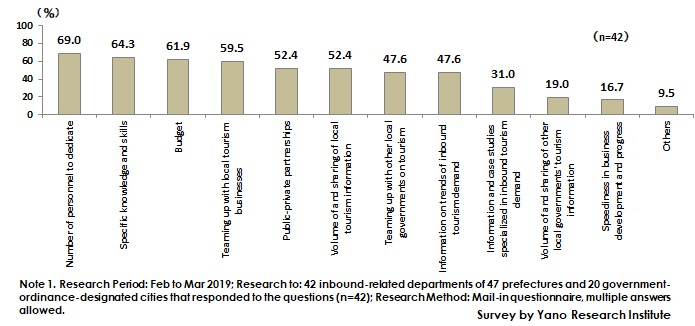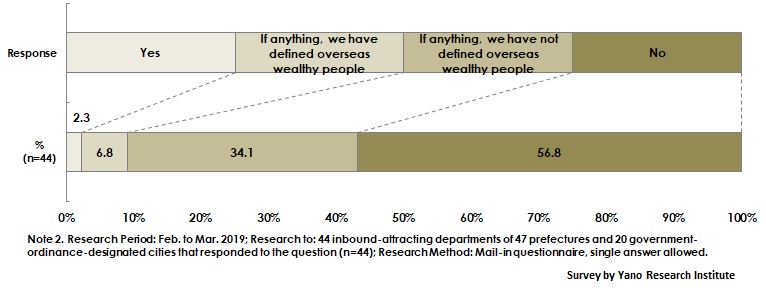No.2156
Questionnaire to Nationwide Local Governments on Enticing Inbound Tourism in Japan: Key Research Findings 2019
Problems at Local Governments to Attract Inbound Tourism Demand are “People” “Money” and “Knowledge & Skills”
Yano Research Institute (the President, Takashi Mizukoshi) has conducted a questionnaire to 47 prefectures and 20 government-ordinance-designated cities throughout the nation about enticing inbound tourism demand, and has found out the status of how various measures taken, the progress of the attempts, and the challenges from the viewpoints of personnel and budget. Here, the results of the analysis regarding the organizational problems are covered.


Summary of Research Findings
The Japanese government has pressed ahead with various measures since 2012 when it aimed to create a tourism nation. While the central government has contributed by relaxing visa requirements, revision of laws and regulations and arranging subsidized projects, it is important to identify the local elements in each region to attract the tourists and to smoothly accept visitors at their destinations. In other words, the main role to attract and accept foreign visitors by creating appealing tourist destinations and upgrading tourism industries to fit traveler needs is undoubtedly dependent on the local governments.
In such a status, Yano Research Institute has carried out a questionnaire to each local government regarding what problems they have been facing when trying to attract foreign visitors. The following items within the questionnaire have been found out to be the problems for about 60% of the respondent local governments: “Number of personnel to dedicate (69.0%)”; “Specific knowledge and skills (64.3%)”; “Budget (61.9%)”; and “Teaming up with local tourism businesses 59.5%).”
Especially, “Number of personnel to dedicate” has accounted for 69.0%, indicating increase of the personnel has been the most challenging issue.
The second largest percentage has been gained by “specific knowledge and skills,” indicating how the governments face the qualitative issue as the same level as the issues of basic resources such as personnel and budget. It seems to be because the following issues have become indispensable for current tourism measures: To align with the travel agencies dealing with overseas tours, to exhibit at some travel exhibitions, to give so-called “Familialization Trips” for travel agencies and etc., to issue information proactively in SNS, and to use influencer marketing. Therefore, securing of “personnel” and “financial resources” has not been enough to attain the goal.
Noteworthy Topics
The questionnaire has confirmed about whether overseas wealthy people were defined at local governments (any plans to specifically attract overseas wealthy people) or not: 34.1% responded that “If anything, we have not defined overseas wealthy people,” and 56.8% responded “No,” totaling to occupy 90.9%. Most of the governments seem to have not considered of the overseas riches. Another question in the questionnaire has found out that a certain number of local governments have taken measures specifically to attract overseas wealthy people, but have not defined such people. In addition, other different question has found out that they have not identified the needs and characteristics of the overseas riches.
Attracting overseas rich people has been one of the keywords to expand tourist spending, but the governments have not identified the conditions of the targets to which they sell something, which seems to be somewhat irrelevant. Currently, only the keyword “Overseas riches” exists, and the analysis on how they act and what they need under what conditions seems to be not finished yet. It is true that there are various types of overseas riches so that defining is difficult, but it seems to be necessary to accurately understand who they are in order to convey the messages and to appropriately provide the well-pondered merchandises and services.
Incidentally, many survey reports and documents define the wealthy people as those who have the financial assets worth US$ 1million or more, but whether the definition is appropriate or not is hard to judge. The private banking service departments at domestic megabanks define the wealthy people that they provide service to as those expected to transact 1 billion yen or more. The inbound-specific divisions at travel agencies set them as those who can consume minimum 100 thousand yen per day, and those who spend several millions yen during one trip.
Research Outline
2.Research Object: 47 prefectures and 20 government-ordinance-designated cities
3.Research Methogology: Questionnaire mailed
Questionnaire to Nationwide Local Governments on Enticing Inbound Tourism
A questionnaire to 47 prefectures and 20 government-ordinance-designated cities throughout the nation about enticing inbound tourism demand has been carried out, aiming to find out the status of how various measures have been taken, the progress of the attempts, and the challenges viewed from the perspectives of personnel and budget. The attempts to attract overseas wealthy people have specifically been reported here. Here, the results of the analysis regarding the organizational challenges and the definition of wealthy people are covered.
Published Report
Contact Us
The copyright and all other rights pertaining to this report belong to Yano Research Institute.
Please contact our PR team when quoting the report contents for the purpose other than media coverage.
Depending on the purpose of using our report, we may ask you to present your sentences for confirmation beforehand.